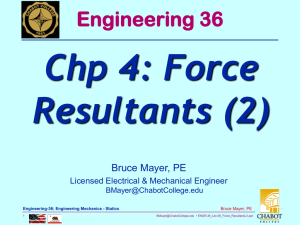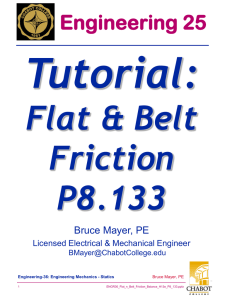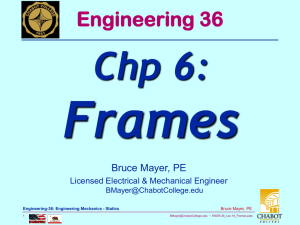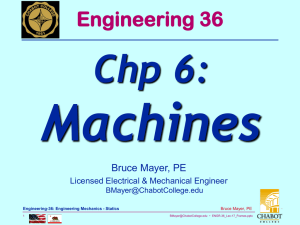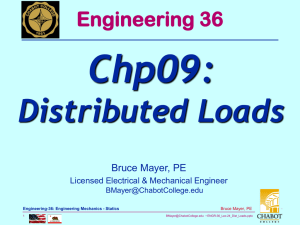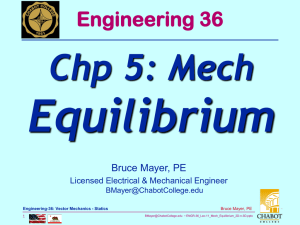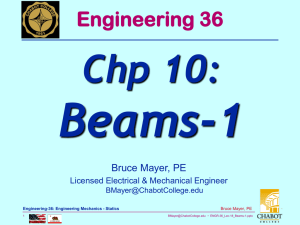ENGR-36_Lec-21_Flat-Friction
advertisement
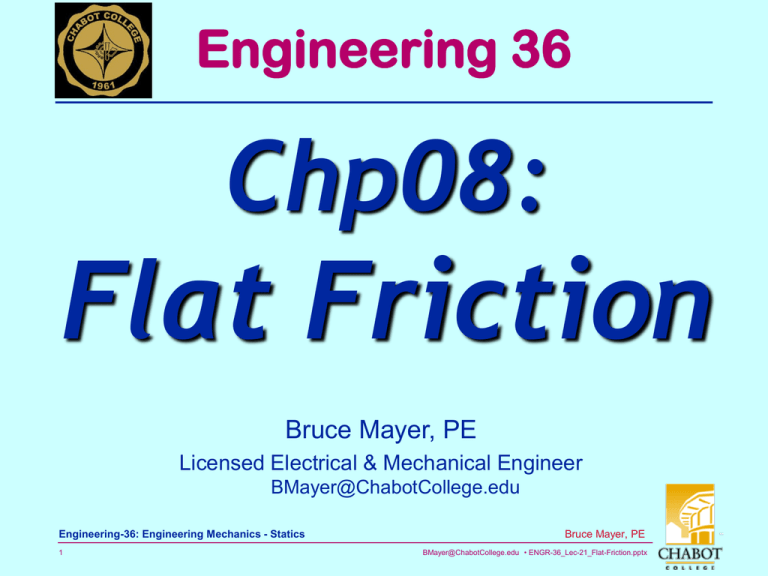
Engineering 36 Chp08: Flat Friction Bruce Mayer, PE Licensed Electrical & Mechanical Engineer BMayer@ChabotCollege.edu Engineering-36: Engineering Mechanics - Statics 1 Bruce Mayer, PE BMayer@ChabotCollege.edu • ENGR-36_Lec-21_Flat-Friction.pptx Outline - Friction The Laws of Dry Friction • Coefficient of Static Friction • Coefficient of Kinetic (Dynamic) Friction Angles of Friction • Angle of Static Friction • Angle of Kinetic Friction • Angle of Repose Wedge & Belt Friction • Self-Locking & Contact-Angle Engineering-36: Engineering Mechanics - Statics 2 Bruce Mayer, PE BMayer@ChabotCollege.edu • ENGR-36_Lec-21_Flat-Friction.pptx Friction Physics When Two Bodies in Contact Attempt to Move Laterally (Sideways) Opposing Tangential Forces Develop Between The two bodies • The Tangential Force is Called FRICTION – Friction Forces Caused Primarily by Surface MicroRoughness Engineering-36: Engineering Mechanics - Statics 3 Bruce Mayer, PE BMayer@ChabotCollege.edu • ENGR-36_Lec-21_Flat-Friction.pptx Coefficient of Friction Consider the Block of Weight W, Balanced by the Normal Reaction Force N. A Lateral Push, P, is Applied to the Block, The Push will Be Balanced, Up to a Point, By The Friction Force, F The Friction Force Rises With P Until The Block Reaches the “Break-Away” Condition and Motion Ensues Engineering-36: Engineering Mechanics - Statics 4 Bruce Mayer, PE BMayer@ChabotCollege.edu • ENGR-36_Lec-21_Flat-Friction.pptx Coefficient of Friction cont. After Break-Away, The Block Accelerates per a m F x m P Fk Experiment Shows That The Resisting Friction Force Follows a General Profile as Noted in Fig.c Below Engineering-36: Engineering Mechanics - Statics 5 Bruce Mayer, PE BMayer@ChabotCollege.edu • ENGR-36_Lec-21_Flat-Friction.pptx Coefficient of Friction cont.2 Experiments Also Show that the MAXIMUM Resisting Force Just Prior to Break Away, Fm, is LINEAR With The Normal Contact Force, N • The Constant of (Linear) Proportionality is Called the Coefficient of STATIC Friction and is Defined by s Fm / N Engineering-36: Engineering Mechanics - Statics 6 Fm s N Bruce Mayer, PE BMayer@ChabotCollege.edu • ENGR-36_Lec-21_Flat-Friction.pptx Coefficient of Friction cont.3 Similarly After Break NOTE: Before BreakAway, The Coefficient of Away the Fiction Force Friction Under Moving, or Does NOT = Fm KINETIC, Conditions • Before Impending Motion F friction P k Fk / N Thus if µs or µk is Known, These Friction Forces Can Be Calculated a-Priori Fm s N Fk k N Engineering-36: Engineering Mechanics - Statics 7 C o e ffic ie n t o f F rictio n S u rfa c e s µs µk S te e l o n s te e l (d ry) 0 .6 0 .4 S te e l o n s te e l (g re a s y) 0 .1 0 .0 5 T e flo n o n s te e l 0 .0 4 1 0 .0 4 B ra k e lin in g o n c a s t iro n 0 .4 0 .3 R u b b e r tire s o n d ry p a ve m e n t 0 .9 0 .8 M e ta l o n ic e 0 .0 2 2 0 .0 2 Bruce Mayer, PE BMayer@ChabotCollege.edu • ENGR-36_Lec-21_Flat-Friction.pptx Rigid Body Friction The Actions of Friction Forces Divide into 4 Distinct Cases 1. NO Lateral Forces to Generate Resisting Tangential Forces → NO Friction Forces (Fig.a) 2. The applied force tends to move body along the surface of contact but are NOT large enough to set it in motion (Fig.b) NOT At BreakAway so F friction F m s N Engineering-36: Engineering Mechanics - Statics 8 Bruce Mayer, PE BMayer@ChabotCollege.edu • ENGR-36_Lec-21_Flat-Friction.pptx R.B. Friction cont. The Actions of Friction Forces Divide into 4 Distinct Cases 3. The applied forces are such that the body is just about to slide, MOTION IS IMPENDING (Fig.c) The Static Case Where The Friction Equation CAN Be Applied F Fm s N 4. The body Slides under the action of the applied forces (Fig.d) The equations of Static equilibrium no Longer Apply. (Kinetic case) Engineering-36: Engineering Mechanics - Statics 9 Bruce Mayer, PE BMayer@ChabotCollege.edu • ENGR-36_Lec-21_Flat-Friction.pptx Angle of Friction Consider the Situation Depicted at Right s • Block of Mass M • Angle of Inclination s • Impending Motion Thus s Summing Forces: F • Static Equilibrium Applies • Anti-Sliding Friction Force Described by F friction F m s N Apply Equilibrium Analysis Engineering-36: Engineering Mechanics - Statics 10 y 0 N Mg cos s N Mg cos s F or so x 0 s N Mg sin s 0 s Mg cos s Mg sin s s Mg sin s Mg cos s tan s Bruce Mayer, PE BMayer@ChabotCollege.edu • ENGR-36_Lec-21_Flat-Friction.pptx Angle of Friction cont. Thus The CoEfficient of Friction is EASILY Measured with a Simple Inclined Plane Once Motion Begins Experiment Shows That The Angle of Inclination can be REDUCED without Halting the Slide Reducing The Angle to Where Motion Stops Defines the Kinetic Coefficient of Friction Engineering-36: Engineering Mechanics - Statics 11 k tan k For Angles of Inclination, , Greater than s The Body Slides per μk and k N Fk Mg sin So the block accelerates per Newton’s Eqn Bruce Mayer, PE BMayer@ChabotCollege.edu • ENGR-36_Lec-21_Flat-Friction.pptx Angle of Friction – 4 Cases The Angle of Friction Also Divides into 4 Cases 1. Angle of Inclination, = 0 → NO Friction (Fig.a) 2. <s → Below BreakAway so the The block is in not motion and friction force is not overcome (Fig.b) Engineering-36: Engineering Mechanics - Statics 12 Bruce Mayer, PE BMayer@ChabotCollege.edu • ENGR-36_Lec-21_Flat-Friction.pptx Angle of Friction – 4 Cases cont. The Angle of Friction Also Divides into 4 Cases 3. With increasing angle of inclination, motion will soon become impending. At that time, the angle between R and the normal will have reached its maximum value s (Fig.c) The value of the angle of inclination corresponding to impending motion is called the ANGLE OF REPOSE S Angle of Repose Engineering-36: Engineering Mechanics - Statics 13 Bruce Mayer, PE BMayer@ChabotCollege.edu • ENGR-36_Lec-21_Flat-Friction.pptx Angle of Friction – cont.2 The Angle of Friction Also Divides into 4 Cases 4. With Further increases in the angle of inclination, motion occurs and the Resultant force, R, Applied by the Inclined plane on the Body no Longer Balances the Gravity Force (Fig.d). The Body is not in Equilibrium so This case Will NOT be Considered in this STATICs Course. You’ll Take up This Subject in The DYNAMICS Course at The Transfer Institution Engineering-36: Engineering Mechanics - Statics 14 Bruce Mayer, PE BMayer@ChabotCollege.edu • ENGR-36_Lec-21_Flat-Friction.pptx ME104 Dynamics @ UCB Engineering-36: Engineering Mechanics - Statics 15 Bruce Mayer, PE BMayer@ChabotCollege.edu • ENGR-36_Lec-21_Flat-Friction.pptx Classes of Friction Problems I. II. III. Static Force Problems Involving Friction Tend to Divide into Three Classes All of the applied forces are given and the coefficients of friction are known; need to determine whether the body considered will REMAIN AT REST or SLIDE. All applied forces are given and the motion is known to be impending; need to determine the value of the COEFFICIENT OF STATIC FRICTION. The static friction coefficient is known, and it is known that motion is impending in a given direction; need to determine the MAGNITUDE OR DIRECTION OF ONE OF THE APPLIED FORCES Engineering-36: Engineering Mechanics - Statics 16 Bruce Mayer, PE BMayer@ChabotCollege.edu • ENGR-36_Lec-21_Flat-Friction.pptx Example: Class I Check Equilibrium 36.87 • Determine the Value of the Force REQUIRED for Equilibrium. Assuming That Friction Directly Opposes Sliding, Draw the F.B.D. A 100-lb force acts on a 300-lb block on an inclined plane. The coefficient of friction between the block and the plane are µs = 0.25 and µk= 0.2. Determine whether or not the block is in equilibrium and find the value of the friction force. Engineering-36: Engineering Mechanics - Statics 17 Bruce Mayer, PE BMayer@ChabotCollege.edu • ENGR-36_Lec-21_Flat-Friction.pptx Example: Class I cont. For the F.B.D. Write Eqns of Equilibrium F 0 N 300 lb 5 N 240 lb F y 4 x 0 100 lb 3 300 lb F 5 F 80 lb Engineering-36: Engineering Mechanics - Statics 18 Thus To Maintain Equilibrium. the Friction Forces MUST Add 80lb to the Existing 100lb Push Now Given µs, Find MAX possible Value for F Fm s N 0 . 25 240 lb Fm 60 lb (only) Since The Block Can Only Generate 60lbs of Frictional Resistance When it Needs 80lbs, The Block WILL SLIDE Bruce Mayer, PE BMayer@ChabotCollege.edu • ENGR-36_Lec-21_Flat-Friction.pptx Example: Class I cont.2 To Find The ACTUAL Value for the Friction Force, Note that the Block is in Kinetic motion (Sliding) so µk Applies F friction F k k N 0 . 2 240 lb F friction 48 lb The Actual Situation Displayed in Diagram at Right Engineering-36: Engineering Mechanics - Statics 19 Note that the Forces are UNBALANCED. • The Block will Accelerate Downward due to the Net Lateral Force of 32lbs (180-148) Bruce Mayer, PE BMayer@ChabotCollege.edu • ENGR-36_Lec-21_Flat-Friction.pptx Example – Class III A large rectangular shipping crate of height h and width b rests on the floor. A Dock Worker Applies a force P to the Upper-Right Edge of the Crate. Assume that the material in the crate is uniformly distributed so that the weights acts at the Geometric centroid of the crate. Determine a) the conditions for which the crate is on the verge of sliding b) the conditions under which the crate will tip about point A Engineering-36: Engineering Mechanics - Statics 20 Bruce Mayer, PE BMayer@ChabotCollege.edu • ENGR-36_Lec-21_Flat-Friction.pptx Example – Class III cont Draw a Free-Body-Diagram of the Crate, noting that the Pressure Applied by the Floor Decreases at the Right-Bottom Edge as The Worker Applies a Greater Push. From The FBD the Eqns of Equilibrium Including the Friction Force F: Fx 0 F P F M y 0 N W A 0 N x W 0.5 b P h Engineering-36: Engineering Mechanics - Statics 21 Bruce Mayer, PE BMayer@ChabotCollege.edu • ENGR-36_Lec-21_Flat-Friction.pptx Example – Class III cont.2 In Equilbrium • F=P • N=W Substituting These Values in the moment equation Yields The Location for the Application of the Resultant Normal Force. By ∑MA=0 0 W x W 0.5 b P h x 0.5 b If the crate is on the verge of sliding F=µsN where µs is the coefficient of static friction . Engineering-36: Engineering Mechanics - Statics 22 P Ph W W Psliding Fs s N Bruce Mayer, PE BMayer@ChabotCollege.edu • ENGR-36_Lec-21_Flat-Friction.pptx Example – Class III cont.3 Now, if the crate is on the verge on tipping it is just about to rotate about point A, so the crate and the floor are in contact ONLY at PointA. Therefore the Normal-Resultant Application Point has moved to Point-A, and Hence x=0 Setting x to Zero in the Moment Equation Yields the TIPPING Condition of ∑MA = 0: W b Ph 2 Engineering-36: Engineering Mechanics - Statics 23 P Wb 2h Bruce Mayer, PE BMayer@ChabotCollege.edu • ENGR-36_Lec-21_Flat-Friction.pptx Example – Class III cont.5 Which will Happen FIRST; Tipping or Sliding? Note that tipping will occur before sliding, provided that Psliding > Ptipping. So if P increases until some Sort of motion occurs Tipping will occur BEFORE Sliding by: b Pslide sW Ptip W 2h TIPPING sW b 2h Engineering-36: Engineering Mechanics - Statics 24 W Pslide Ptip s b 2h Bruce Mayer, PE BMayer@ChabotCollege.edu • ENGR-36_Lec-21_Flat-Friction.pptx Example – Class III cont.6 Run The Numbers. Make Some Realistic Assumptions • • • • b = 3 feet h = 5 feet W = 300 lb µs = 0.5 for Wood on ConCrete http://www.adtdl.army.mil /cgi-bin/atdl.dll/fm/334.343/apph.pdf Engineering-36: Engineering Mechanics - Statics 25 Bruce Mayer, PE BMayer@ChabotCollege.edu • ENGR-36_Lec-21_Flat-Friction.pptx Example – Class III cont. ReCall the Tipping Criteria s , min ,tip b 2h In this case b 2 h 3 / 2 5 0 . 3 So Since The Actual Friction Factor of 0.5 EXCEEDS this value, then the Crate WILL, in fact, TIP OVER Calc The Overturning and Sliding Pushes b 3 Ptip W 2h 2 5 300 lb 90 lb Pslide sW 0 . 5 300 lb 150 lb Engineering-36: Engineering Mechanics - Statics 26 Bruce Mayer, PE BMayer@ChabotCollege.edu • ENGR-36_Lec-21_Flat-Friction.pptx CoEffs of Friction Engineering-36: Engineering Mechanics - Statics 27 Bruce Mayer, PE BMayer@ChabotCollege.edu • ENGR-36_Lec-21_Flat-Friction.pptx WhiteBoard Work Let’s Work This Nice Problem Two blocks A and B have a weight of 10 lb and 6 lb, respectively. They are resting on the incline for which the coefficients of static friction are µA = 15% and µB = 25%. Determine the incline angle for which both blocks begin to slide. Also find the required stretch or compression in the connecting spring for this to occur. The spring has a stiffness of k = 2 lb/ft. Engineering-36: Engineering Mechanics - Statics 28 Bruce Mayer, PE BMayer@ChabotCollege.edu • ENGR-36_Lec-21_Flat-Friction.pptx Engineering 36 Appendix dy dx sinh µx T0 µs T0 Bruce Mayer, PE Registered Electrical & Mechanical Engineer BMayer@ChabotCollege.edu Engineering-36: Engineering Mechanics - Statics 29 Bruce Mayer, PE BMayer@ChabotCollege.edu • ENGR-36_Lec-21_Flat-Friction.pptx Engineering-36: Engineering Mechanics - Statics 30 Bruce Mayer, PE BMayer@ChabotCollege.edu • ENGR-36_Lec-21_Flat-Friction.pptx Fun with Friction Engineering-36: Engineering Mechanics - Statics 31 Bruce Mayer, PE BMayer@ChabotCollege.edu • ENGR-36_Lec-21_Flat-Friction.pptx Measure Coeff ofDynamic Friction Use concept of SpringMass Damped Harmonic Motion as studied in Physics and Engineering25 Engineering-36: Engineering Mechanics - Statics 32 Bruce Mayer, PE BMayer@ChabotCollege.edu • ENGR-36_Lec-21_Flat-Friction.pptx Engineering-36: Engineering Mechanics - Statics 33 Bruce Mayer, PE BMayer@ChabotCollege.edu • ENGR-36_Lec-21_Flat-Friction.pptx Engineering-36: Engineering Mechanics - Statics 34 Bruce Mayer, PE BMayer@ChabotCollege.edu • ENGR-36_Lec-21_Flat-Friction.pptx Engineering-36: Engineering Mechanics - Statics 35 Bruce Mayer, PE BMayer@ChabotCollege.edu • ENGR-36_Lec-21_Flat-Friction.pptx Engineering-36: Engineering Mechanics - Statics 36 Bruce Mayer, PE BMayer@ChabotCollege.edu • ENGR-36_Lec-21_Flat-Friction.pptx Engineering-36: Engineering Mechanics - Statics 37 Bruce Mayer, PE BMayer@ChabotCollege.edu • ENGR-36_Lec-21_Flat-Friction.pptx 3 kN 5m Engineering-36: Engineering Mechanics - Statics 38 3 kN 7m 5m Bruce Mayer, PE BMayer@ChabotCollege.edu • ENGR-36_Lec-21_Flat-Friction.pptx
